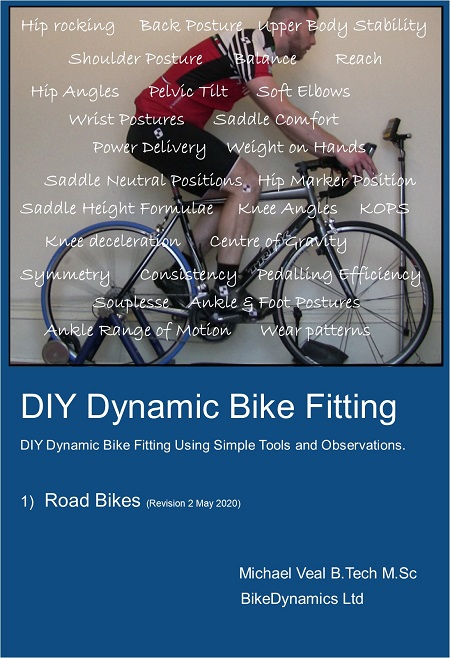Muscle Activation around the Pedal Stroke.
The bike fitting process is enhanced by understanding the muscle groups active around the pedal stroke. This is often demonstrated by splitting the 360° stroke into four quadrants, but I suggest that discussing particular points, and what happens between them can be more informative. These points are characterized by being the transition between an extensor or flexor moment for either the hip or knee joint.
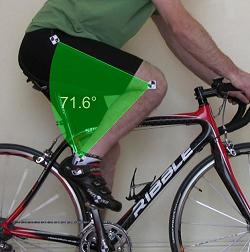
Position 1 - Minimum Knee angle
This point is characterized by being the minimum distance between the pedal spindle and hip joint. At this position, the knee joint angle reaches its minima, undergoing a transition from knee flexion to knee extension. Prior to this point, the Hamstrings have been active; flexing the knee, but this reduces in favour of the Quads activating to extend the knee. With little contribution from the knee at this point, the primary active muscle groups are the hip flexors, particularly the Iliopsoas, Rectus femoris and Sartorius. Tibialis Anterior, which dorsiflexes the ankle, will also be active, especially if the rider purposefully drops the heel on the upstroke.

Position 2 - Minimum Hip Angle
This point is characterized by reaching the minimum hip angle (femur to torso), so we experience a transition from hip flexion to hip extension. With little contribution from the hip, the primary active muscle group becomes the Quads (Rectus femoris, Vastus laterallis, Vastus intermedialis, and Vastus medialis). From this point onwards the Quads combine with the Gluteus maximus to provide the knee and hip extension respectively that forms the bulk of the power generation mechanism.
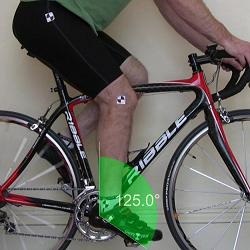
Position 3 - Minimum Knee Torque
This point around the cycle is interesting as the torque at the knee joint reduces to zero. This is because the diminishing extensor moment due to the Quads is balanced by an increasing flexor moment from the Hamstrings and Gastrocnemius. There is still considerable force being applied at the pedals due to hip extension (Gluteus maximus). Stability of the ankle is maintained by the calf muscles Gastrocnemius and Soleus.
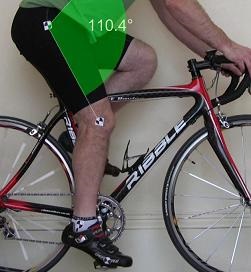
Position 4 - Maximum Hip Angle, Maximum Knee Angle.
At this position the hip and knee joints reach maximum extension before returning to flexor mechanisms. With minimal contribution from the hip, the Hamstrings (Biceps femoris, Semimembranosus, and Semitendinosus) become the most active muscle group, primarily flexing the knee. The Gastrocnemius also helps to flex the knee and combines with the Soleus to plantar-flex the ankle at the bottom of the stroke.
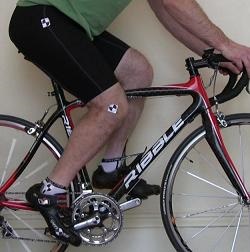
Position 4 to 1, The Upstroke
If you were to measure the pedal loads of most cyclists, (even the good ones), the force applied to the pedals would still be downwards for most of the upstroke. Most of this is due to gravitational and inertial effects. Many cyclists at least attempt to unweight the pedals in this region, if not actively pull up (especially on hills). The primary active muscle groups in this region are the hip flexors and ankle dorsiflexors.
Muscle Groups and the Length -Tension Relationship.
Understanding the muscle groups involved when cycling helps to confirm the guidelines used for bike fitting, particularly saddle position, torso angles and crank length. Before exploring these issues in more detail it is worth discussing a key physical characteristic of muscles called the length tension relationship.
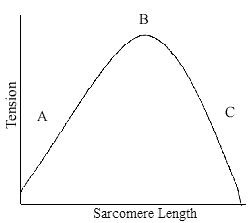
Sarcomere Length - Tension
Greatest tension is developed at point B (slightly stretched) with less tension developed at points A (contracted) and C (stretched).
What this means is that, for any given muscle, its ability to generate tension (and so produce power) is in the central section of its range of movement. With the peak being at a slightly stretched position.
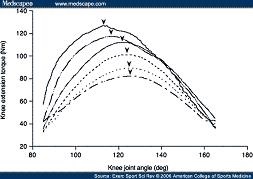
Knee Extension Torque v Angle
This characteristic is very well demonstrated by this graph showing the extension torque of the knee joint against joint angle (for a range of extension velocities - fast cycling speeds being the lowest curves). We know the knee often articulates over a range between 65° and 145° so as cyclists we can be assured we are using our knees to their best advantage. It is worth noting the diminishing returns as the knee angle tightens and fully opens, which has significant consequences for crank lengths and saddle height.
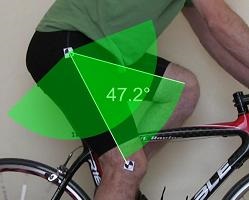
Hip Range of Movement
The range of movement of the hip whilst cycling is smaller than the total available. The total range can vary between individuals but we can see how by leaning forwards (and so inclining the top of the pelvis forwards), the cyclist will bring the Gluteus Maximus into the ideal slightly stretched region for most of its activity.This is at the expense of the hip flexors including one of the Quads (Rectus femoris) that are effectively shortened by this forward tilt, becoming less effective. Like the knee extensors, the Hamstrings are active over a wide range of movement. By being at full stretch at the bottom of the pedal stroke they are primed to be effective during the knee flex phase on the upstroke.
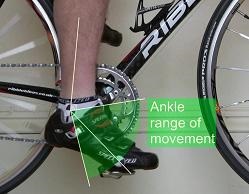
Ankle Range of Movement
The range of motion of the ankle joint is approximately 60°, of which a typical cyclist will use 15°-20°. Ankle behaviours can be quite diverse though with some people preferring to be strongly plantar-flexed (toe down) around the stroke, whilst others are strongly dorsiflexed (often having attended spinning classes and told to keep their heels down). Some people push their heels down approaching the top of the pedal stroke, especially whilst climbing. This has the benefit of opening the knee joint into a more powerful region. Ideally the ankle would be plantar-flexed at the bottom of the stroke i.e. the heel will be higher than the toe. This will put the ankle at an ideal point along the length tension relationships of the calf muscles (Gastrocnemius and Soleus) earlier in the stroke when pedal loads are at their highest.
DIY Dynamic Bike Fitting
You may be interested in our downloadable DIY guide.
49 Page PDF download describing all the observations, simple measurements and calculations required to do your own Dynamic Bike Fits.
Revision 2 released May 2020.
Contains updated male and female saddle height calculators and new information on male / female leg length proportions. Plus a new section to assist with saddle choice and improving comfort.
British Pound, Euro and US Dollar payments are processed by PayPal and all major credit cards are accepted. You will receive an email confirming your payment and will be automatically redirected to a page where you can download the ebook. The ebook is in PDF format so you will need to have a copy of Adobe Acrobat Reader or a similar PDF reader to read the ebook.

